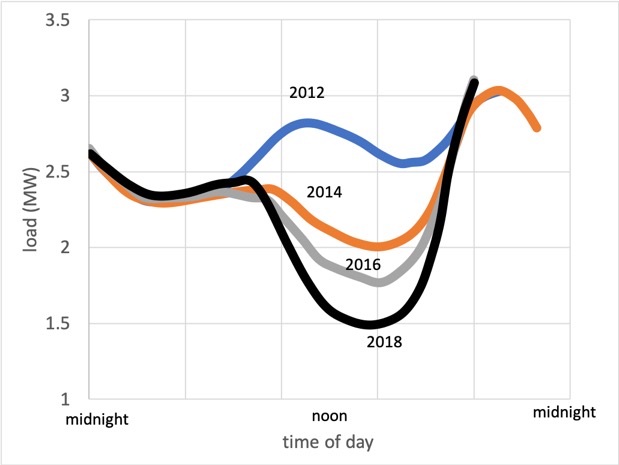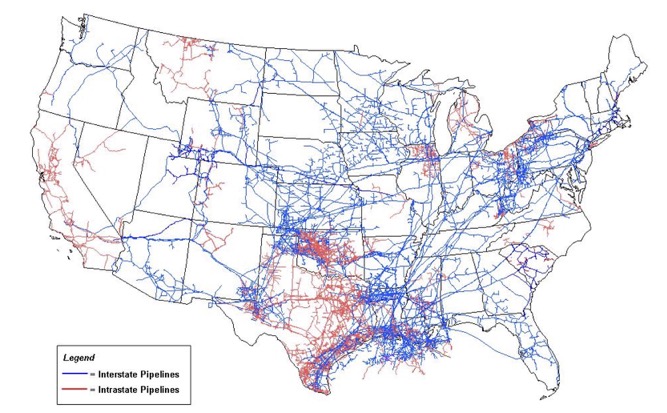Recipe
In a tank, add 5 liters of natural gas. (You can use quarts if that makes you happier.) Now add 1 liter of pure hydrogen. Don’t bother to stir. You’re done. Use like natural gas.
OK, it’s not quite that simple, but it’s awfully close. You can make hydrogen with renewable energy, like solar power, and shove it into the existing natural gas infrastructure, immediately achieving storage capacity of at least several days, thus completely fixing the problems with daily storage that plagues solar power, and with essentially zero dollars down. This doesn’t get you out of longer-term challenges like stormy weather, or winter versus summer, but it does wipe out the problem of solar generation taking care of you during the day but abandoning you at night. And it has a long-term path to a pure hydrogen distribution system that supplements (or replaces) the existing electric power system, while providing massive storage capacity. But it’s still mostly just a dream. Why?
OK, first let’s take a look at the problem we’re trying to solve. The curves below are examples of what's known in the power industry as the "California Duck Curve": the need for generated power dips during the day when sun shines on solar panels, and then zooms up again in the evening.

Figure 1: the California Duck Curve (data from Hamdan [1]), showing increased slopes as the years go by and more solar panels are installed.
The California Duck Curve doesn’t look much like a duck to me. I asked some ducks at the local Community Center what they thought, but they were worried about their remarks being posted out of context on Twitter, which they think is a mouthpiece for ridiculous birds that tweet instead of quacking.

Figure 2: California ducks.
Whatever the ducks think, the curve named after them is a real problem. When you install a lot of solar generation capacity that works best when the sun is up, but still expect to always have electricity available, the result is a highly variable requirement for non-solar electricity. In the morning, people are waking up, businesses are starting (at least in non-pandemic times) and electric power use increases. But then the sun comes up. When the sun rises the need for generation falls, as solar panels take the load. That’s not necessarily a bad thing, but then later in the day the sun sets, and suddenly lots of generation has to be turned on. As you can see from the graphs, this behavior has become more dramatic with the passing of the years, as more solar capacity is installed.
Clearly, what would be helpful is to store the solar energy at noon and use it in the evening. There are a number of approaches to the problem. Conventional lithium batteries can certainly be used to start, but there isn’t enough lithium and cobalt in the world to solve the whole problem [2]. Flow batteries (batteries that use a species dissolved in a liquid to store electrochemical energy) are an option, as is gravitational storage. But a very scalable approach is: use electrolysis to generate hydrogen. Now, as you recall from the introduction to this series, hydrogen takes up a lot of space unless you compress it like crazy. But we have a perfect place to put it that has lots and lots of space: the existing natural gas infrastructure. The natural gas system as of a decade ago is shown in Figure 3 (these things don't change too fast). The system has over a million miles (1.6 million km) of pipe, at various pressures from around 40 to 140 atmospheres. A very rough guess is that the total volume of the system is around 2x1012 cubic feet or 6x1013 liters, at an average pressure of something like 50 atmospheres. If that wild estimate is correct, there's room for about 1013 kWh of energy stored as pure hydrogen, which is more than US electricity use in a year [3]. These numbers should not be taken too seriously, but they suggest there's quite a bit of room.

Figure 3: US natural gas pipeline system as of 2009, from Melaina et. al. [2].
A more detailed examination of the problem, focused on southern California, has been performed by Professor Brouwer and his student A. Carmona, of the University of California at Irvine [4]. They found that about 650 GWh could be stored in the regional gas district using only 5% hydrogen, presumed to be generated by a solar farm to be placed east of San Diego. This is on the order of 1 day's energy use for all of California, or perhaps 2-3 days for the southern region, based on total use of about 195 TWh per year [5]. So there is indeed lots of room.
Is it practical and safe to mix hydrogen with natural gas? Hydrogen is much lighter than methane (the main constituent of natural gas), but they have similar viscosity — resistance to flow. Hydrogen releases a bit less energy per volume, but in a 5% or 10% mixture that's not likely to be an issue. Domestic uses — gas stoves, ovens, and furnaces — are pretty much unaffected by 10% hydrogen [6]. The particular steel used in most gas pipelines is reasonably immune to leakage and embrittlement, the two things that the tiny hydrogen molecules can do to some materials. There's a tiny increase in explosion dangers for people within a few meters of an explosion, but the risk is reduced for people more than 100 meters away [2]. At high concentrations, the depleted oil/gas fields sometimes used to store natural gas may experience increased bacteria growth and the release of toxic hydrogen sulfide; salt caverns are fine. The one application that just doesn't tolerate hydrogen is a compressed-natural-gas motor, sometimes used on trucks and other vehicles.
To test this out, the people at UC Irvine, working with Southern California Edison, have done a pilot project reaching up to 3.8% hydrogen (by volume) in natural gas on the campus, using local electrolysis (splitting of water into hydrogen and oxygen). They have injected over 4000 kilograms of hydrogen to power a turbine generator normally run on pure natural gas [7].
This all seems pretty promising, and it isn't being ignored, especially in Europe, where a number of projects are running or about to launch [8]:
- HyDeploy: university test, like UC Irvine
- Hystock: 1 MW power-to-gas, Netherlands
- Jupiter 1000: electrolysis + “smoke capture” ⇒ CH4
- Methycentre: mix of biogas and hydrogen, start 2021
- Hycaunais: biomethane + electrolysis, trial 2021
- Hygreen: solar PV + electrolysis + local salt caverns, target 3x106 kg H2/year by 2025 (equivalent of 12 MW)
However, all these projects are on the order of 1 MW each. That is pretty tiny compared to the many gigawatts of storage envisioned above. The GRTGaz report is looking at serious implementation starting in 2030 or beyond, with scale achieved in 2050. Now, it's worth noting that things appear to be moving a bit faster in some countries, notably Australia, where GW-scale projects for hydrogen and ammonia are being discussed and even started [9]. It's easy to understand why this might be so: Australia has lots of sunlight, a limited internal market, and the opportunity to export to all of Asia if an international market comes into being. So they might be willing to take more risks than places like the US, where natural gas is plentiful due to fracking. But it's then more puzzling that Europe is moving so slowly, since they import much of their natural gas from Russia, causing various geopolitical inconveniences.
So what's going on? In retrospect, this is the obvious consequence of using something that's already been built, and is huge. There are massive investments, both financial and social, in the existing system. Even modest changes or risks will encounter a lot of resistance, even when the owners and users are enlightened folks trying to improve. The negative consequences of messing up are large and the perceived benefits are not, or at least are far in the future. So even though little or no fundamental technology is needed, it is going to take a long time to convert the natural gas system from methane to hydrogen.
